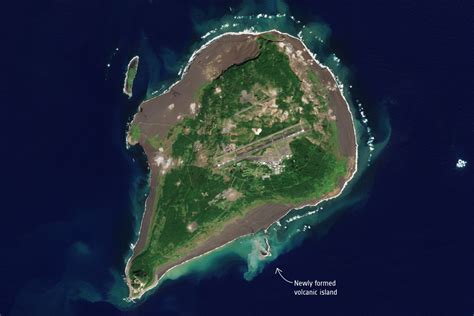
A previously unknown island has emerged in the Caspian Sea, discovered by Russian scientists during a recent expedition. The island, located near the northern part of the sea, is believed to have formed due to fluctuating water levels, a characteristic feature of the Caspian.
Russian scientists, while conducting routine monitoring of the Caspian Sea’s coastline, stumbled upon the new landmass. “During planned monitoring work, we discovered an island that was not previously marked on any geographical maps,” stated Arseny Yegorov, a representative from the Russian Academy of Sciences. The discovery highlights the dynamic nature of the Caspian Sea’s geography and the potential for further changes in the region.
Details of the Discovery
The discovery occurred during a comprehensive survey conducted by researchers affiliated with the Russian Academy of Sciences. The expedition focused on assessing the ecological conditions and mapping the ever-changing coastline of the Caspian Sea. It was during this meticulous process that the uncharted island was identified.
The island’s precise location remains tightly controlled, with scientists hesitant to reveal the exact coordinates to prevent unregulated access and potential ecological damage. Preliminary estimates suggest the island is relatively small, but its emergence carries significant implications for navigation, environmental management, and future research endeavors in the Caspian region.
The Russian team is now focused on conducting more detailed surveys to determine the island’s size, composition, and stability. These studies will also investigate the potential impact of the new landmass on local ecosystems and marine life.
Caspian Sea Level Fluctuations: A Key Factor
The Caspian Sea is the world’s largest inland body of water, bordered by five countries: Russia, Iran, Azerbaijan, Turkmenistan, and Kazakhstan. One of its defining characteristics is its fluctuating water level, which has varied significantly over the centuries. These fluctuations are driven by a complex interplay of factors, including rainfall, evaporation rates, river inflows, and climate change.
Over the past few decades, the Caspian Sea has experienced both periods of rising and falling water levels. The current trend points towards a decline, which has exposed previously submerged areas and created new coastal features like the newly discovered island.
“The Caspian Sea’s water level is subject to cyclical variations, leading to the emergence of new landforms and the disappearance of others,” explained Dr. Irina Sokolova, a leading expert in Caspian Sea hydrology. “These changes have profound consequences for the region’s ecology, economy, and infrastructure.”
Impact on Ecology and Marine Life
The emergence of a new island in the Caspian Sea can have both positive and negative impacts on the region’s ecology. On one hand, it could provide new habitat for various species of plants and animals. Birds, in particular, may find the island to be an ideal nesting ground, while certain types of vegetation could colonize the newly exposed land.
On the other hand, the island could also disrupt existing ecosystems and alter the distribution of marine life. The introduction of new species to the island could have unforeseen consequences for the local food web. Additionally, the island’s presence could affect water currents and sediment transport, potentially impacting coastal erosion and the health of nearby wetlands.
“We need to carefully monitor the ecological changes that occur as a result of the island’s emergence,” said Dr. Yegorov. “This will help us to understand the long-term impacts on the Caspian Sea’s biodiversity and develop strategies to mitigate any negative effects.”
Implications for Navigation and Maritime Activities
The discovery of a new island presents challenges for navigation and maritime activities in the Caspian Sea. Existing nautical charts and navigational systems will need to be updated to reflect the island’s presence. Ships and boats will need to be aware of the island’s location to avoid collisions and potential grounding.
“The safety of navigation is paramount,” stated Captain Dimitri Volkov, a maritime safety officer. “We are working closely with the Russian authorities to ensure that all vessels operating in the Caspian Sea are informed about the new island and its potential hazards.”
In addition to navigation, the island could also impact other maritime activities, such as fishing and offshore oil and gas exploration. These activities may need to be adjusted to minimize disturbance to the island’s environment and ensure sustainable resource management.
Potential for Future Research and Exploration
The newly discovered island offers exciting opportunities for future research and exploration. Scientists can study the island’s geology, soils, and vegetation to gain insights into the processes that led to its formation. They can also investigate the island’s colonization by plants and animals, providing valuable data on ecological succession and adaptation.
“This island is a natural laboratory for studying ecological change,” said Professor Elena Petrova, a botanist specializing in Caspian Sea flora. “It offers a unique opportunity to observe how ecosystems develop from scratch and how species respond to new environmental conditions.”
The island could also be used as a base for monitoring the long-term changes in the Caspian Sea’s environment. Scientists can establish research stations on the island to track water levels, temperature, salinity, and other key parameters. This data can help to improve our understanding of the Caspian Sea’s dynamics and predict future changes in the region.
Geopolitical Considerations
The Caspian Sea’s resources and strategic location make it a region of geopolitical importance. The discovery of a new island could potentially lead to disputes over maritime boundaries and resource rights. The five countries bordering the Caspian Sea have been engaged in negotiations for many years to establish a clear legal framework for the region, and the emergence of a new landmass could complicate these discussions.
“It is essential that all Caspian Sea states cooperate to resolve any potential disputes arising from the island’s discovery,” said Ambassador Sergei Lavrov, a Russian diplomat specializing in Caspian Sea affairs. “We must ensure that the region remains a zone of peace, stability, and cooperation.”
The potential for resource exploitation on or around the island also raises concerns about environmental protection. Strict regulations and monitoring mechanisms will be needed to prevent pollution and ensure sustainable development in the area.
Environmental Challenges Facing the Caspian Sea
The Caspian Sea faces numerous environmental challenges, including pollution, overfishing, and invasive species. These challenges are exacerbated by the sea’s fluctuating water level and the increasing pressure from human activities.
Pollution from industrial and agricultural sources is a major concern, with significant quantities of pollutants entering the sea from rivers and coastal areas. These pollutants can harm marine life, contaminate seafood, and degrade water quality.
Overfishing has also depleted many fish stocks in the Caspian Sea, threatening the livelihoods of local communities that depend on fishing. Unsustainable fishing practices, such as the use of illegal nets and the targeting of spawning fish, have contributed to the decline in fish populations.
Invasive species, such as the comb jellyfish, have had a devastating impact on the Caspian Sea’s ecosystem. These species can outcompete native species for food and resources, disrupt food webs, and cause significant economic damage.
“Addressing these environmental challenges requires a concerted effort from all Caspian Sea states,” said Dr. Natalia Ivanova, an environmental scientist specializing in Caspian Sea conservation. “We need to implement effective policies to reduce pollution, manage fisheries sustainably, and control invasive species.”
Historical Context of Caspian Sea Level Changes
The Caspian Sea’s water level has fluctuated dramatically throughout history. Geological evidence suggests that the sea was once connected to the Black Sea and the Mediterranean Sea. During the last ice age, the Caspian Sea’s level was much lower than it is today.
In more recent times, the Caspian Sea has experienced periods of both rising and falling water levels. In the 20th century, the sea’s level fell by several meters between the 1930s and the 1970s, causing significant economic and social disruption.
Since the late 1970s, the Caspian Sea’s level has generally been rising, but this trend has reversed in recent years. The current decline in water level is causing concern among scientists and policymakers, who are worried about the potential impacts on the region’s environment and economy.
“Understanding the historical context of Caspian Sea level changes is crucial for predicting future trends and developing effective adaptation strategies,” said Dr. Sergei Petrov, a geologist specializing in Caspian Sea history. “We need to learn from the past to prepare for the future.”
Technological Advancements in Monitoring the Caspian Sea
Modern technology plays a crucial role in monitoring the Caspian Sea and understanding its complex dynamics. Satellite imagery, remote sensing, and advanced modeling techniques are used to track water levels, monitor pollution, and assess the health of ecosystems.
Satellite imagery provides a comprehensive overview of the Caspian Sea, allowing scientists to observe changes in water level, coastline, and vegetation cover. Remote sensing techniques, such as radar and lidar, can be used to measure water depth, detect oil spills, and map underwater features.
Advanced modeling techniques are used to simulate the Caspian Sea’s dynamics and predict future changes in water level, temperature, and salinity. These models can help to inform decision-making and guide the development of adaptation strategies.
“Technological advancements are revolutionizing our ability to monitor and understand the Caspian Sea,” said Dr. Olga Kuznetsova, a remote sensing specialist. “These technologies provide us with valuable data that can help us to protect the sea’s environment and manage its resources sustainably.”
Future Outlook for the Caspian Sea
The future of the Caspian Sea is uncertain, but several factors will likely shape its evolution in the coming years. Climate change is expected to have a significant impact, potentially leading to further declines in water level and changes in temperature and salinity.
Human activities, such as oil and gas exploration, fishing, and agriculture, will continue to exert pressure on the Caspian Sea’s environment. Sustainable management practices and effective environmental regulations will be needed to mitigate these impacts.
International cooperation among the Caspian Sea states will be crucial for addressing the region’s challenges and ensuring a sustainable future for the sea. Joint efforts are needed to monitor the environment, manage resources, and resolve potential disputes.
“The Caspian Sea is a valuable resource that requires careful management and international cooperation,” said Dr. Andrei Smirnov, a political scientist specializing in Caspian Sea affairs. “We must work together to ensure that the sea remains a healthy and productive ecosystem for future generations.”
FAQ: Frequently Asked Questions about the New Caspian Sea Island
-
How was the new island discovered?
The island was discovered by Russian scientists during routine monitoring of the Caspian Sea’s coastline. According to Arseny Yegorov from the Russian Academy of Sciences, it was found “during planned monitoring work” and was “not previously marked on any geographical maps.”
-
What caused the formation of the island?
The formation of the island is primarily attributed to the fluctuating water levels of the Caspian Sea. The sea’s water level is subject to cyclical variations, which can lead to the emergence of new landforms as previously submerged areas become exposed.
-
Where exactly is the island located?
The exact location of the island has not been publicly disclosed. Scientists are hesitant to reveal the precise coordinates to prevent unregulated access and potential ecological damage. It is known to be near the northern part of the Caspian Sea.
-
What are the potential environmental impacts of the island’s emergence?
The island’s emergence could have both positive and negative impacts on the Caspian Sea’s ecology. It could provide new habitat for certain species, but it could also disrupt existing ecosystems and alter the distribution of marine life. Monitoring and mitigation efforts are necessary to manage these impacts.
-
What are the implications for navigation in the Caspian Sea?
The discovery of the new island requires updates to nautical charts and navigational systems to ensure the safety of maritime activities. Ships and boats need to be aware of the island’s location to avoid collisions and grounding. Expanded Sections and In-depth Analysis
A Closer Look at Caspian Sea Level Fluctuations:
The Caspian Sea’s level fluctuations are not merely a recent phenomenon; they represent a long-term geological and climatic trend. Understanding the underlying causes requires examining a complex interplay of factors:
- Climate Change: Global warming contributes to increased evaporation rates, reducing the amount of water in the sea. Altered precipitation patterns also play a role, with some regions experiencing decreased rainfall and river runoff into the Caspian.
- River Inflow: Major rivers like the Volga, Ural, and Terek are the primary sources of water for the Caspian Sea. Changes in their flow rates, due to upstream dam construction, irrigation projects, or natural variations, significantly impact the sea’s level. For instance, excessive water diversion for agriculture can reduce the amount of water reaching the Caspian, exacerbating the decline.
- Evaporation: The Caspian Sea’s large surface area and warm climate make it susceptible to high evaporation rates. Increased temperatures further amplify this effect, causing more water to be lost to the atmosphere.
- Precipitation: Local rainfall directly contributes to the Caspian Sea’s water level. However, precipitation patterns in the region are highly variable, with periods of drought followed by periods of heavy rainfall.
- Geological Activity: While less significant than the other factors, geological processes, such as tectonic movements and seabed subsidence, can also influence the Caspian Sea’s level over long timescales.
These factors interact in complex ways, making it challenging to predict future water level changes accurately. However, climate models suggest that the Caspian Sea is likely to continue to experience a decline in water level in the coming decades, posing significant challenges for the region.
Ecological Significance of the Caspian Sea:
The Caspian Sea is a biodiversity hotspot, home to a unique assemblage of plants and animals found nowhere else on Earth. Its ecological significance stems from several factors:
- Endemic Species: The Caspian Sea is home to numerous endemic species, meaning they are found only in this region. These include the Caspian seal (the world’s smallest seal), various species of sturgeon (renowned for their caviar), and several unique fish and invertebrate species.
- Migratory Bird Habitat: The Caspian Sea serves as a crucial stopover point for millions of migratory birds traveling between Europe, Asia, and Africa. Its wetlands and coastal areas provide essential feeding and resting grounds for these birds, many of which are threatened or endangered.
- Fisheries: The Caspian Sea supports a significant fishery, providing livelihoods for local communities and contributing to regional economies. Sturgeon, carp, and other fish species are harvested for both domestic consumption and export.
- Unique Ecosystems: The Caspian Sea encompasses a variety of ecosystems, including shallow coastal lagoons, deepwater basins, and extensive delta regions. Each of these ecosystems supports a distinct community of plants and animals, contributing to the sea’s overall biodiversity.
Protecting the Caspian Sea’s ecological integrity is crucial for preserving its unique biodiversity and ensuring the sustainable use of its resources. This requires addressing the numerous environmental challenges facing the region, including pollution, overfishing, and habitat loss.
Geopolitical Implications of Resource Management:
The Caspian Sea is rich in natural resources, particularly oil and natural gas. These resources have made the region a focal point of geopolitical interest, with the five Caspian Sea states vying for control and access to these valuable assets. The legal status of the Caspian Sea, and the division of its seabed and resources, have been the subject of lengthy negotiations among the littoral states.
- Resource Rights: The primary point of contention has been whether the Caspian Sea should be considered a “sea” or a “lake.” If classified as a sea, it would be subject to international maritime law, allowing for the division of the seabed into sectors based on equidistance principles. If classified as a lake, it would be subject to different legal principles, potentially requiring a consensus-based approach to resource management.
- Pipeline Politics: The transportation of oil and natural gas from the Caspian Sea region to global markets has been a source of intense competition. Various pipeline projects have been proposed and implemented, each with its own geopolitical implications. These pipelines not only provide access to valuable resources but also strengthen the economic and political ties between the producing and consuming countries.
- Military Presence: The Caspian Sea is also a zone of military competition, with each of the littoral states maintaining naval forces in the region. The presence of these forces reflects the strategic importance of the Caspian Sea and the need to protect national interests.
The discovery of the new island adds another layer of complexity to the geopolitical landscape of the Caspian Sea. The ownership and control of the island, and any resources that may be found in its vicinity, will likely be subject to negotiations and potential disputes among the littoral states.
Addressing Environmental Challenges: A Collaborative Approach:
Protecting the Caspian Sea’s environment requires a collaborative approach involving all five littoral states. Several international agreements and initiatives have been established to address the region’s environmental challenges:
- The Tehran Convention: This framework convention provides a legal basis for cooperation on environmental protection in the Caspian Sea region. It covers a wide range of issues, including pollution prevention, biodiversity conservation, and sustainable resource management.
- The Caspian Environment Programme (CEP): This programme aims to promote sustainable development and environmental protection in the Caspian Sea region through regional cooperation and capacity building.
- National Action Plans: Each of the Caspian Sea states has developed national action plans to address specific environmental challenges in their respective territories. These plans outline strategies for reducing pollution, managing fisheries sustainably, and protecting biodiversity.
Despite these efforts, significant challenges remain. Implementing effective environmental regulations and enforcing compliance are crucial for protecting the Caspian Sea’s environment. Increased investment in environmental monitoring and research is also needed to improve our understanding of the region’s dynamics and develop effective solutions.
Technological Innovation for Sustainable Management:
Technological innovation is playing an increasingly important role in the sustainable management of the Caspian Sea. Advances in remote sensing, data analysis, and environmental monitoring are providing valuable tools for tracking changes in the sea’s environment and assessing the effectiveness of conservation efforts.
- Satellite Monitoring: Satellite imagery is used to monitor water levels, track pollution plumes, and assess the health of coastal ecosystems. This data can be used to identify areas of concern and guide the development of targeted interventions.
- Underwater Robotics: Underwater robots and drones are used to explore the seabed, collect samples, and monitor marine life. These technologies provide access to remote and inaccessible areas, allowing scientists to study the Caspian Sea’s deepwater ecosystems.
- Data Analytics: Advanced data analytics techniques are used to analyze large datasets from various sources, including satellite imagery, environmental monitoring stations, and research surveys. This data can be used to identify trends, predict future changes, and evaluate the effectiveness of management strategies.
By harnessing the power of technology, we can improve our understanding of the Caspian Sea and develop more effective strategies for its sustainable management.
The Future of Caspian Sea Research:
The discovery of the new island underscores the need for continued research and monitoring in the Caspian Sea region. Future research efforts should focus on several key areas:
- Island Formation Dynamics: Studying the processes that led to the island’s formation can provide insights into the long-term dynamics of the Caspian Sea and help to predict future changes in its coastline.
- Ecological Colonization: Monitoring the colonization of the island by plants and animals can provide valuable data on ecological succession and adaptation. This information can be used to inform conservation strategies and manage the potential impacts of new landforms on existing ecosystems.
- Resource Assessment: Conducting resource assessments in the vicinity of the island can help to determine its economic potential and guide the development of sustainable resource management plans.
- Climate Change Impacts: Studying the impacts of climate change on the Caspian Sea’s water level, temperature, and salinity is crucial for predicting future changes and developing effective adaptation strategies.
By investing in research and monitoring, we can improve our understanding of the Caspian Sea and ensure its sustainable management for future generations. The discovery of the new island serves as a reminder of the dynamic nature of this unique ecosystem and the need for continued vigilance and collaboration. The discovery also underscores the limitations of current mapping technologies and the need for more frequent and comprehensive surveys of the Caspian Sea region. Modern technologies such as high-resolution satellite imagery and unmanned aerial vehicles (UAVs) could be deployed to provide a more detailed and up-to-date picture of the coastline and identify any other previously unknown landforms. Long-Term Implications and Adaptive Strategies
The discovery of the new island necessitates a comprehensive evaluation of the long-term implications for the Caspian Sea region, spanning environmental, economic, and geopolitical dimensions. Crucially, it highlights the pressing need for adaptive strategies to mitigate the challenges posed by fluctuating water levels and ensure sustainable development.
Environmental Adaptive Strategies:
- Coastal Zone Management: Implementing integrated coastal zone management plans that account for the dynamic nature of the coastline is essential. These plans should incorporate measures to protect vulnerable ecosystems, such as wetlands and coastal lagoons, from the impacts of sea level changes and human activities.
- Early Warning Systems: Developing early warning systems to predict and respond to extreme events, such as floods and droughts, can help to minimize the impacts on coastal communities and ecosystems. These systems should integrate data from various sources, including weather forecasts, hydrological models, and remote sensing imagery.
- Ecosystem Restoration: Investing in ecosystem restoration projects can help to enhance the resilience of coastal ecosystems to sea level changes and other environmental stressors. These projects may involve restoring degraded wetlands, planting mangrove forests, and creating artificial reefs.
- Pollution Control: Strengthening pollution control measures is crucial for protecting the Caspian Sea’s water quality and preventing the degradation of coastal ecosystems. This includes reducing the discharge of industrial and agricultural pollutants, improving wastewater treatment facilities, and promoting sustainable agricultural practices.
Economic Adaptive Strategies:
- Diversification of Economic Activities: Diversifying economic activities away from sectors that are highly dependent on the Caspian Sea’s resources, such as fishing and oil and gas exploration, can help to reduce the vulnerability of coastal communities to sea level changes and resource depletion. This may involve promoting tourism, agriculture, and other sustainable industries.
- Infrastructure Adaptation: Adapting existing infrastructure, such as ports, roads, and pipelines, to withstand the impacts of sea level changes is essential. This may involve raising the elevation of infrastructure, reinforcing coastal defenses, and relocating vulnerable assets.
- Sustainable Fisheries Management: Implementing sustainable fisheries management practices can help to ensure the long-term health of fish stocks and protect the livelihoods of local fishing communities. This includes setting catch limits, enforcing fishing regulations, and promoting sustainable fishing gear.
- Renewable Energy Development: Investing in renewable energy sources, such as solar and wind power, can help to reduce reliance on fossil fuels and mitigate climate change, which is a major driver of sea level changes.
Geopolitical Adaptive Strategies:
- Regional Cooperation: Strengthening regional cooperation among the Caspian Sea states is essential for addressing the shared challenges of sea level changes and resource management. This includes sharing data and information, coordinating policies, and developing joint management plans.
- Dispute Resolution Mechanisms: Establishing effective dispute resolution mechanisms can help to prevent conflicts over maritime boundaries and resource rights, particularly in light of the emergence of new landforms.
- Transparency and Accountability: Promoting transparency and accountability in resource management can help to ensure that the benefits of resource exploitation are shared equitably and that environmental impacts are minimized.
- International Law and Diplomacy: Engaging with international law and diplomatic forums can help to establish a clear legal framework for the Caspian Sea region and promote peaceful resolution of disputes.
By implementing these adaptive strategies, the Caspian Sea states can enhance their resilience to the challenges posed by sea level changes and ensure a sustainable future for the region. The discovery of the new island serves as a wake-up call, highlighting the urgency of addressing these challenges and working together to protect the Caspian Sea’s environment and resources. It also provides an opportunity for renewed dialogue and cooperation among the littoral states, fostering a spirit of collaboration in the face of shared challenges.









